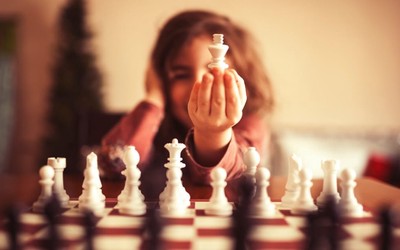
Canva
What Is Considered a Good ELO Score for Recreational Players? (Is 1400 Good?)
Is a 1400 ELO good for a recreational chess player? Find out in this blog! We dive into ELO scores, expectations, and what it means to be “good” for casual players. Enjoy the game and keep improving, regardless of your rating!You know what sucks?
Being stuck at a chess rating that makes you feel like a loser.
You’ve been playing for years, studying the game, practicing the puzzles, and reading chess books, but you can’t seem to break past the 1400 barrier.
I get it.
In the back of your mind, you wonder, "Am I not smart enough for this game?"
Let me stop you right there.
Your skill level has nothing to do with intelligence. Chess prowess comes from practice, not inborn talent. If you've made it to 1400, you should feel proud. That rating puts you in the top third of recreational players. No small feat! But that doesn't make the frustration go away, does it?
The truth is, an ELO score doesn't define your value as a player. So let go of unrealistic rating goals that leave you feeling inadequate.
Instead, focus on growth and enjoying the game. Find fulfillment in small wins, like finally nailing down a tricky opening. Or teaching your niece those chess basics you've worked so hard to understand yourself.
Progress takes time. But you've already come this far.
So silence that inner critic, and let's talk about what makes for a "good" rating at your level.
Sounds good?
Then let's get started.
Understanding ELO Scores
ELO ratings are a dynamic system used to measure chess skill. Developed by Arpad Elo, the system assigns a numerical score to each player, reflecting their relative strength. Players gain or lose points based on their results against others, with victories against higher-rated players resulting in a larger gain and vice versa.
This creates a dynamic system where players constantly strive to improve their ratings. ELO ratings are generally categorized into classifications that reflect a player’s overall proficiency:
- Beginner: < 1200 ELO
- Intermediate: 1200-1600 ELO
- Advanced: 1600-2000 ELO
- Expert: 2000+ ELO
https://chesspicks.com/wp-content/uploads/2023/12/3-1024x536.jpg
It’s important to note that different platforms use slightly different ELO calculations and scales. For example,Chess.com uses a Glicko-2 system, while FIDE (the International Chess Federation) uses a traditional Elo rating system. These differences may lead to slight variations in individual ratings across platforms.
Defining “Good” for Recreational Players
What constitutes a “good” ELO score for a recreational player depends on several factors, including:
- Personal goals: Are you simply looking to enjoy the game and improve at your own pace? Or do you aspire to participate in tournaments and compete against other players?
- Playing experience: How long have you been playing chess? How often do you play and practice?
- Enjoyment of the game: Do you prioritize having fun and learning over achieving a specific rating?
A recreational player’s expectations and definition of “good” will differ significantly from those of a professional or competitive player. The key takeaway is that a good ELO score is a relative measure, and its value should be assessed within the context of your individual goals and enjoyment of the game.
Analyzing a 1400 ELO Score
According to theUSCF Rating distribution chart, a 1400 ELO score falls within the “intermediate” player category. This means you have likely mastered the basic rules, tactics, and opening principles. You can identify simple threats and opportunities on the board, and you are capable of holding your own against players of similar ratings.
Here are some specific examples of what a 1400 player can typically achieve:
- Defeat most casual players and beginners.
- Participate in local chess clubs and tournaments.
- Enjoy competitive games with other 1400-1600-rated players.
- Continue improving their skills and aiming for higher ELO goals.
Is 1400 Good? The Answer
Yes, 1400 is considered a solid intermediate classification. At 1400 ELO, a player has grasped deeper insight into the game compared to a casual beginner.
A 1400 ELO player utilizes tactics appropriately, develops positions intelligently by identifying opportunities and weaknesses, and has knowledge of common opening principles.
Whether a 1400 ELO score is “good” for you as a recreational player depends entirely on your own definition of “good.” If you’re enjoying the game, learning new skills, and achieving your individual goals, then your ELO score is irrelevant.
However, if you aspire to reach higher levels of competitive play, achieving a 1400 rating could be a stepping stone to further improvement.
Generally, an ELO between 1200 and 1600 or 1700 indicates good skills for casual play. This shows a player has progressed past the beginner level and developed an intermediate understanding of tactics, positional play, openings and other fundamental chess knowledge.
Ultimately, the focus for recreational players should be on enjoying the game, learning continuously, and celebrating individual achievements regardless of the number on their ELO rating.
https://chesspicks.com/wp-content/uploads/2023/12/2-1024x536.jpg
Additional Points to Consider
- Improvement takes time and practice: Don’t get discouraged if your ELO fluctuates. Consistent practice and dedication are key to long-term improvement.
- Resources for improvement: Utilize online resources, chess books, and training tools to enhance your skills. Chess.com lessons and lichess.org are good starting points for beginners.
- Join a chess club or participate in tournaments: Immerse yourself in the chess community and learn from other players.
This post was first published at Chesspicks.com

